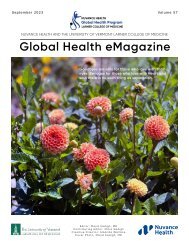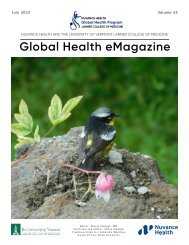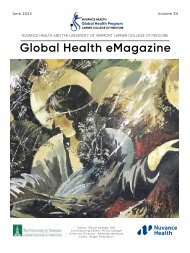eMagazine January 2023
You also want an ePaper? Increase the reach of your titles
YUMPU automatically turns print PDFs into web optimized ePapers that Google loves.
OUR PEOPLE,<br />
OUR MISSION<br />
Global Health<br />
<strong>eMagazine</strong><br />
<strong>January</strong> <strong>2023</strong><br />
Perspective<br />
Highlights<br />
Reflections<br />
Innovation and Technology<br />
Nursing Division<br />
Women’s Health Education<br />
Global Local<br />
Art to Remind Us of Who<br />
We Can Be<br />
Article of the Month<br />
Video of the Month<br />
Our Beautiful Planet<br />
Welcome<br />
Congratulations<br />
Among the Letters<br />
Global Health Family<br />
Calendar<br />
Photo News<br />
Photo Gallery<br />
Resources<br />
The Voice of Uganda<br />
Fibroids: The Silent Pandemic<br />
Written by Joshua Matusuko<br />
Medical student at MaKCHS<br />
One morning while clerking female patients<br />
admitted to the gynecology ward at<br />
Kawempe National Referral Hospital, I<br />
noticed that more than 50% of patients<br />
were suffering from uterine fibroids. One<br />
particular patient, a 36-year-old nulligravid<br />
woman, had a 12-year history of irregular<br />
menstrual bleeding lasting more than<br />
two weeks, pressure symptoms, and a pelvic mass. She had been waiting<br />
for her scheduled myomectomy for over five months and still had hopes of<br />
one day carrying a child. On further clerking of patients with uterine fibroids,<br />
one complaint common was that they were in line for surgical therapy<br />
(myomectomy and hysterectomy. Once diagnosed and the decision is made<br />
for surgical therapy, patients at Kawempe had to wait between 5 to 12 months<br />
to the day of surgery, primarily due to the very high number of patients on the<br />
waiting list, with some patients having to wait almost an entire year.<br />
Uterine fibroids are the biggest causes of benign uterine masses and currently<br />
one of the biggest gynecological concerns in the country. Some studies have<br />
indicated a prevalence as high as 28.2% with about 70% being symptomatic<br />
(https://doi.org/10.24248/ EASci.v4i1.x © Adawe et al). Management options<br />
in private facilities normally are extremely high in cost for the average<br />
Ugandan with gynecological consultations only ranging 50,000 - 150,000<br />
Ugandan shillings (UGX) (13.4 - 41.23 USD) depending on the private hospital.<br />
For women who want non-hormonal medical treatment, especially for those<br />
who want to have children or do not feel comfortable with hormonal therapy,<br />
tablets such as Tranexamic at a cost of 1,500 UGX per tablet and can be<br />
taken for as long as the doctor determines. Meanwhile Mefenamic acid costs<br />
500 UGX per tablet. Hormonal treatments which normally offer a wider range<br />
of options such as combined oral contraceptives cost 8,000 UGX per month<br />
while injectables cost 5,000 UGX per injection. There are more expensive<br />
tablets such as Ulipristal which costs 8,000 UGX per tablet, making the total<br />
cost 240,000 UGX per month. One may need to take these for three months.<br />
There are also injections that help shrink the fibroids such as Zoladex and<br />
Luprodex and cost 350,000 - 400,000 UGX per month.<br />
Then for patients in for surgical treatment, one of the new surgical<br />
interventions for fibroids in Uganda is Uterine Artery Embolization (UAE) which<br />
14

















